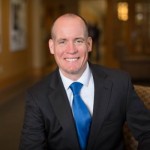Social media in higher education is always full of surprises – often amazingly good and sometimes pretty bad.
Surprises come with the territory, but so does routine with social media work.
That’s why I wanted to know the most surprising social media outcome the 12 presenters of the 2015 Higher Ed Social Media Conference experienced.
Check out these 12 surprising social media outcomes your higher ed colleagues have witnessed and find out what they’ve learned in the process.
Dominique Benjamin, Digital & Social Media Specialist – Duke University
 Like many people, I was hesitant to jump on the Periscope bandwagon, but our initial experiments with the platform garnered a surprising level of engagement.
Like many people, I was hesitant to jump on the Periscope bandwagon, but our initial experiments with the platform garnered a surprising level of engagement.
Without any kind of promotion, more than 200 people tuned in to watch one of our first live scopes.
It was especially interesting to watch the comments and hearts coming in from the live audience. It was then that I began to understand, from the viewers’ perspective, the appeal of engaging with content creators in real-time and how we might be able to capitalize on that for future ‘scopes.
Candace Nelson, Senior Writer, University Relations/News – West Virginia University
 One of the biggest social media surprises that West Virginia University experienced this year was the response to a new campaign. WVU hosted an “Ask WVU” Snapchat session a week before freshman were due to move to campus to help answer those last-minute questions.
One of the biggest social media surprises that West Virginia University experienced this year was the response to a new campaign. WVU hosted an “Ask WVU” Snapchat session a week before freshman were due to move to campus to help answer those last-minute questions.
While we anticipated a handful of questions – especially considering the platform – we were not prepared for the hundreds of questions that flooded our WestVirginiaU Snapchat handle. While it was a welcome and exciting response, we know the next time we host a similar campaign to have more hands on deck and to block off our whole day to tend to the inquiries.
Kate Post, Digital Media Specialist – California State University, Chico
 The most surprising thing this year for me was discovering the value of Snapchat.
The most surprising thing this year for me was discovering the value of Snapchat.
I wavered on launching an account for most of the spring, but was finally persuaded by my student intern just before the end of the semester that there was no harm in trying it. I was envisioning worst-case scenarios—students sending us snaps of them doing inappropriate activities, or that they didn’t really want “Big Brother†University in this space, for example—but was pleasantly surprised to discover none of those were true.
We launched during spring finals week (a week before graduation) by announcing on Twitter and Instagram that we’d made an account, and started a little campaign asking students to send us their “study snaps.†Over the next five days we gained more than a thousand Snapchat followers, and for the campaign received more than 50 “usable†snaps for our campaign. We repurposed those snaps in a Facebook album for parents, alumni, and friends to see, which was a big hit since it played on their nostalgia and support for students. It was a super simple way to showcase the daily lives of our students with both a hint of academic seriousness (a key area of focus in our communications) and a whole lot of personality.
The main lesson of this Snapchat experiment was not to be afraid to give new media a try, and to trust that the same positive, engaged community you’ve built on other platforms will carryover. We continued our “experiment†by reporting from Commencement a week later using Snapchat Stories, and we’ve now fully integrated it in our regular social media strategy to great success!
Lauren Boyd, Multimedia Specialist – The Ohio State University
 Ohio State’s Instagram has taken off — off-the-chart numbers over the past year or two.
Ohio State’s Instagram has taken off — off-the-chart numbers over the past year or two.
At first, I used this as a platform to post pretty pictures of campus, but when I saw the growing numbers, I took a step back and thought, “How can we use this in a more meaningful way?â€
Now, we’re using it in multiple ways — showcasing gorgeous photos of campus, finding and posting user-generated content and telling stories through some long-form captions.
Robert Bochnak, Assistant Director, Alumni Marketing and Communications – Harvard Business School
 I’ve been surprised by how productive Instagram has been for us when it comes to connecting with alumni.
I’ve been surprised by how productive Instagram has been for us when it comes to connecting with alumni.
Last year, we launched our feed in earnest and since the Instagram has outperformed to a large degree—when it comes to likes and comments—our Facebook outreach. The difference in outcomes may be related to the changes Facebook has made to its algorithm, though this would be speculative.
Tiffany Broadbent Beker, Web Developer & Social Media Coordinator – William & Mary
 When the W&M Men’s Basketball team made it to the finals of the CAA tournament with a buzzer-beater final shot, the outpouring of school pride on social media was amazing.
When the W&M Men’s Basketball team made it to the finals of the CAA tournament with a buzzer-beater final shot, the outpouring of school pride on social media was amazing.
W&M is generally not known as a big sports school but this team and its players sparked the spirit of the entire community. Buses were arranged to go up to the championship game in Baltimore, people were using the athletics (#RisingTribe) and tournament (#MarchOnTribe) hashtags all over social media, and school pride was definitely at a peak.
I think since everyone was not able to attend the game in person, or even necessarily go to a watch party in their hometown, that social media served as the convening point. We had nearly 1200 posts on Twitter, Facebook and Instagram using one of the hashtags (710 for the lead-up to the championship game and more than 470 posts for the championship).
There was a lot of inter-departmental planning and strategizing on how we wanted to best use the hashtags and publicize the events and I think that cooperation really helped to make things a success.
Rachel Reuben, Principal – RRC
 Just slightly over a year ago, I had never heard of YikYak before. Then exactly one year ago, it suddenly became our main source of information for a week-long sit-in/demonstration in our admission lobby.
Just slightly over a year ago, I had never heard of YikYak before. Then exactly one year ago, it suddenly became our main source of information for a week-long sit-in/demonstration in our admission lobby.
YikYak seemed to come out of nowhere and gained immediate popularity – so much so on the campus that I previously worked, that there wasn’t much, if any, usage of Twitter to monitor.
YikYak completely took over, and it was ugly. I don’t know how they got “out there†so fast and why this caught on so quickly with college students, but apparently the appeal of being anonymous won them over. It has certainly revealed a whole segment of students who did not feel comfortable sharing certain topics, such as racism, in other social media or campus-provided counseling venues.
At first we only used it as a “heads up†listening outlet. In the months following, we realized there are benefits to posting by members of the student affairs staff, such as the dean of students, with his/her initials, letting students know they have support, that they have resources.
Most recently there were two student deaths, and the university was to connect with the parents and discuss with them before releasing news. Meanwhile, the news started spreading on YikYak, so an administrator posted (with their initials) that they promise a message is coming, that they’re working with the parents. So, it has end up becoming a way – during very special cases, where it can be a two-way dialogue.
Nina Sossen, Director of Social Media – University of Massachusetts
 Perhaps not extremely surprising, since we’ve seen it before, but we’ve again been struck by how much pictures matter more than words.
Perhaps not extremely surprising, since we’ve seen it before, but we’ve again been struck by how much pictures matter more than words.
In a period of a week we had live social media coverage on the visit to campus of, arguably, the most powerful woman in the world, coverage of the annual faculty convocation, and an announcement related to an appearance on campus of the Dalai Lama. But the engagement level on this content was a fraction of the content in response to a single picture we posted of the campus with a story about a new ranking (not actually very impressive numbers) that listed our town as the #27 best college town in America.
In fact, people were not responding as much to the news of the new ranking but just to the photo.
Chelsey Rovesti, Manager of Social Media – Point Park University
 Not necessarily surprising, but I am really happy to see how Facebook video has taken off.
Not necessarily surprising, but I am really happy to see how Facebook video has taken off.
I am excited to see how it continues to progress and how we can continue to optimize our video content with Facebook in mind.
Tracy Payle, Director & Content Strategist – Pickle Jar Communications Ltd
 We were commissioned just recently to fill a resource gap for an institution. Their social media officer had left, and it would be about 6 weeks before the new one would arrive. So, we took over some really basic community management for them as interim cover. During this period they had a visit day on their campus and so we were on hand (but working remotely) to do the social community management for that. The biggest shock to me was how little social interaction there was. Literally through the whole day, only a handful of people were sharing their experience online.
We were commissioned just recently to fill a resource gap for an institution. Their social media officer had left, and it would be about 6 weeks before the new one would arrive. So, we took over some really basic community management for them as interim cover. During this period they had a visit day on their campus and so we were on hand (but working remotely) to do the social community management for that. The biggest shock to me was how little social interaction there was. Literally through the whole day, only a handful of people were sharing their experience online.
We’d managed social media for university visit days for other clients before, and had only ever experienced a really buzzing stream of content. But the difference here is that we hadn’t been asked by the client to put a plan in place for making the most of social media through the day or to help them drive it. It just reminded me that even in 2015 you have to really go for it and really put a lot of effort into maximising social media during live events, even with a young and socially very active audience.
Nikki Sunstrum, Director of Social Media – University of Michigan
 This year we have implemented countless new campaigns and initiatives across University of Michigan social media channels aimed at intentionally elevating diversity of content and the corresponding dialogue.
This year we have implemented countless new campaigns and initiatives across University of Michigan social media channels aimed at intentionally elevating diversity of content and the corresponding dialogue.
Our efforts have allowed us to successfully elevate not only the understanding of our university and the depth and breadth of its academic prestige, but also engage social communities with more robust and educational content. It has been met by overwhelmingly positive response.
Chris Barrow, Social Media and Mobile Products Coordinator – New York University
 The boom I’ve seen in employees interest in social media training.
The boom I’ve seen in employees interest in social media training.
I don’t mean to speak of how to use social media professionally at NYU – but rather – how to use it personally.
I’ve had the tremendous opportunity to train everyone from staff to faculty on important platforms like LinkedIn. People are truly interested in social media – even if their bosses may not have their focus on that area – and training is a MUST.
What about YOU? What has been your most suprising social media outcome?
I would love to hear about your experience as well. Please, don’t be shy and share your biggest social media surprise of 2015 with the rest of us by posting a comment below!
And, if you want to learn more from these great higher ed social media professionals, get a 1-year on-demand pass for your team for the Higher Ed Social Media Conference.





[New Post] 12 Surprising Social Media Outcomes for #HigherEd in 2015 https://t.co/9lf8KAjIB4
New post: College Web Editor – 12 Surprising Social Media Outcomes for #HigherEd in 2015 https://t.co/CClqqUg1zo
College Web Editor – 12 Surprising Social Media Outcomes for #HigherEd in 2015: Social media in higher educati… https://t.co/GedlDIxaYb
College Web Editor – 12 Surprising Social Media Outcomes for #HigherEd in 2015 https://t.co/KhL61fE8Ie
12 Surprising Social Media Outcomes for #HigherEd in 2015 https://t.co/6Une0T7rOT #hesm #casesmc https://t.co/lMwKjbtuGC
RT @higheredexperts: 12 Surprising Social Media Outcomes for #HigherEd in 2015 https://t.co/6Une0T7rOT #hesm #casesmc https://t.co/lMwKjbtu…
RT @higheredexperts: 12 Surprising Social Media Outcomes for #HigherEd in 2015 https://t.co/6Une0T7rOT #hesm #casesmc https://t.co/lMwKjbtu…
RT @higheredexperts: 12 Surprising Social Media Outcomes for #HigherEd in 2015 https://t.co/6Une0T7rOT #hesm #casesmc https://t.co/lMwKjbtu…
RT @higheredexperts: 12 Surprising Social Media Outcomes for #HigherEd in 2015 https://t.co/6Une0T7rOT #hesm #casesmc https://t.co/lMwKjbtu…
RT @higheredexperts: 12 Surprising Social Media Outcomes for #HigherEd in 2015 https://t.co/6Une0T7rOT #hesm #casesmc https://t.co/lMwKjbtu…
From the US: 12 most surprising social media outcomes for HE in 2015: inc Periscope, Snapchat, FB Video
https://t.co/jPYZg5aBHa @karinejoly
12 Surprising Social Media Outcomes for #HigherEd in 2015 https://t.co/uDPgdO6TEL #hesm
Snapchat for Universities- wow! “@Jisc: From the US: 12 most surprising social media outcomes for HE in 2015 https://t.co/9f5pJxGddIâ€
12 Surprising Social Media Outcomes for #HigherEd in 2015 https://t.co/2M7X7SFQJM #hesm #casesmc https://t.co/cVsAC8x4se
RT @Jisc: From the US: 12 most surprising social media outcomes for HE in 2015: inc Periscope, Snapchat, FB Video
https://t.co/jPYZg5aBHa …
12 Surprising #socialmedia Outcomes for #HigherEd in #2015 https://t.co/7uCTp9blm5 https://t.co/3jjWUmxP5J
CollegeWeb: 12 Surprising Social Media Outcomes for #HigherEd in 2015 https://t.co/2CYzopQtsz #Conferences #HigherEd
12 Surprising Social Media Outcomes for #HigherEd in 2015 https://t.co/n6qphWGNE0 #SM
Great #socialmedia snippets from 12 #edtech users on the biggest surprise this yr https://t.co/iq3eQWQnwy #TEDEdChat https://t.co/UclgaV3rdJ
’12 surprising social media outcomes for #HigherEd in 2015′ https://t.co/IpI0bGfmu7 (via @karinejoly) #hesm15
RT @Jisc: ’12 surprising social media outcomes for #HigherEd in 2015′ https://t.co/IpI0bGfmu7 (via @karinejoly) #hesm15
RT @Jisc: ’12 surprising social media outcomes for #HigherEd in 2015′ https://t.co/IpI0bGfmu7 (via @karinejoly) #hesm15
RT @Jisc: ’12 surprising social media outcomes for #HigherEd in 2015′ https://t.co/IpI0bGfmu7 (via @karinejoly) #hesm15
RT @Jisc: ’12 surprising social media outcomes for #HigherEd in 2015′ https://t.co/IpI0bGfmu7 (via @karinejoly) #hesm15
12 Surprising Social Media Outcomes for #HigherEd in 2015 | https://t.co/jr3sHXCr5t https://t.co/8J6eBEIfG6
RT @Jisc: ’12 surprising social media outcomes for #HigherEd in 2015′ https://t.co/IpI0bGfmu7 (via @karinejoly) #hesm15
12 surprising #SocialMedia outcomes for #HigherEd in 2015 https://t.co/sG1ry4KR5h
RT @Jisc: ’12 surprising social media outcomes for #HigherEd in 2015′ https://t.co/IpI0bGfmu7 (via @karinejoly) #hesm15
12 Surprising Social Media Outcomes for #HigherEd in 2015 | https://t.co/N5lT4PD3cU https://t.co/g0F573gDIT
12 Surprising Social Media Outcomes for #HigherEd in 2015 https://t.co/ksoeNZmlGN
12 Surprising Social Media Outcomes for #HigherEd in 2015 https://t.co/cYXGhct3Tv
12 Surprising Social Media Outcomes for #HigherEd in 2015 | https://t.co/lgzPejAJ7k https://t.co/bF6PvCGDRo #edtech
RT @lizgross144: 12 Surprising Social Media Outcomes for #HigherEd in 2015 https://t.co/ksoeNZmlGN
12 Surprising #SocialMedia Outcomes for #HigherEd in 2015 https://t.co/ozr7SALx6a HT @picklejar
12 Surprising Social Media Outcomes for #HigherEd in 2015 | https://t.co/EMDL9av28Q
RT @sabrinaonmove: 12 Surprising Social Media Outcomes for #HigherEd in 2015 | https://t.co/EMDL9av28Q
12 Surprising Social Media Outcomes for #HigherEd in 2015 https://t.co/QVUuu28Y8p #casesmc https://t.co/QR5N46eEdh